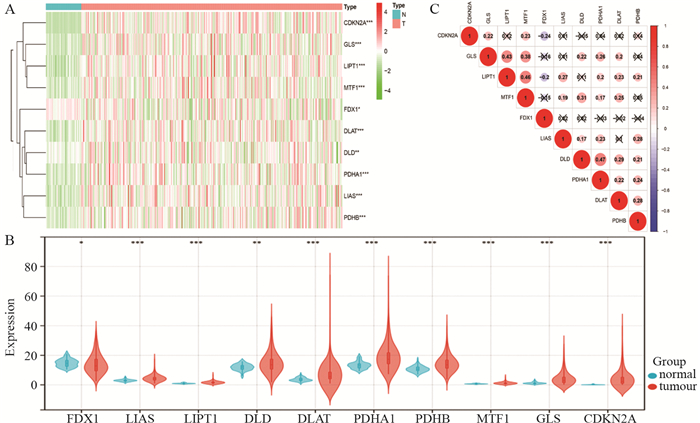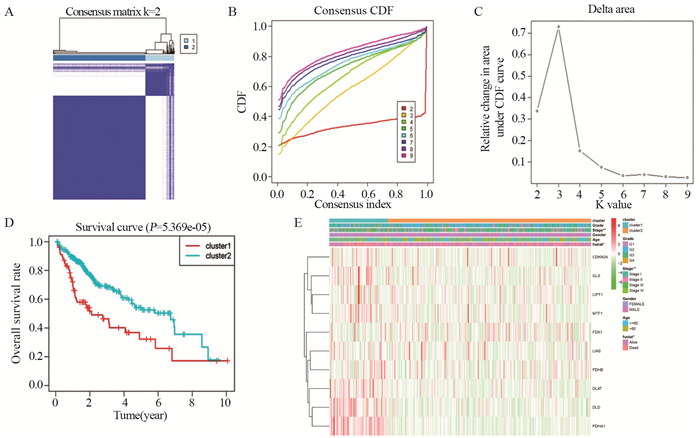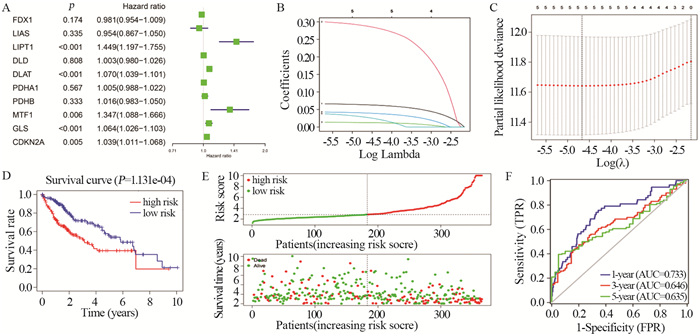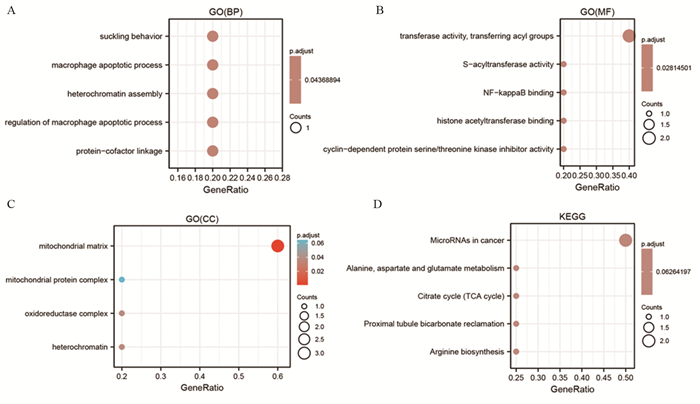-
摘要:目的
探讨铜死亡相关基因与肝癌生存预后的关系。
方法通过收集TCGA数据库中肝癌患者的临床信息和相应的RNA-seq数据,分析10个铜死亡相关基因在肝癌组织和正常组织中的差异表达。进一步使用一致性聚类以确定新的肝癌亚型,比较两个亚型之间总体生存率和临床特征的差异。单因素Cox回归分析筛选与预后相关的铜死亡基因,并利用LASSO回归分析构建风险模型。
结果与正常组织相比,肝癌组织中FDX1表现下调,其余9个基因表现上调。聚类分析示,Cluster1的预后较差。基于单因素Cox回归分析和LASSO回归分析筛选出5个预后相关基因(LIPT1、DLAT、MTF1、GLS、CDKN2A)并构建风险模型。与其他临床特征相比,该预后模型的风险评分被确认为独立的预后因素。
结论通过生物信息学分析构建了5个铜死亡相关基因的肝癌预后模型,有可能作为肿瘤诊断分子标志物和潜在的治疗靶点。
Abstract:ObjectiveTo explore the relationship of cuprotosis-related genes with survival rate and prognosis in patients with liver cancer.
MethodsBy collecting clinical information and corresponding RNA-seq data of patients with liver cancer in the TCGA database, the differential expression levels of 10 cuprotosis-related genes in liver cancer and normal tissues was analyzed. Novel liver cancer subtypes were identified through consistent clustering, and differences in overall survival and clinicopathological factors were compared between the two subtypes. Univariate Cox regression analysis was used in screening cuprotosis genes associated with prognosis, and LASSO regression analysis was used in constructing a risk model.
ResultsFDX1 was down-regulated, and the other nine genes were up-regulated in HCC tissues compared with normal tissues. Cluster analysis showed that the prognosis of Cluster1 was poor. Five prognostic genes (LIPT1, DLAT, MTF1, GLS, and CDKN2A) were screened out through univariate Cox regression analysis and LASSO regression analysis for risk model construction. The risk score of this prognostic model was identified as an independent prognostic factor compared with other clinical features.
ConclusionThrough bioinformatics analysis, a liver cancer prognosis model of five cuprotosis-related genes is constructed, which may be used as molecular markers for tumor diagnosis and are potential therapeutic targets.
-
Key words:
- Bioinformatics /
- Liver cancer /
- Cuprotosis /
- Prognostic model
-
0 引言
男性乳腺癌在临床中比较罕见,发病率占所有乳腺癌的0.9%~1.4%[1-4]。近年来,男性乳腺癌的发病率呈上升趋势,并有研究显示,男性乳腺癌的发病率和死亡率在地区之间存在差异[5]。男性乳腺癌在就诊时多分期较晚,且恶性程度较高,预后较女性乳腺癌差[6-7]。由于其发病率低,目前针对于男性乳腺癌的诊断和治疗标准均参照女性乳腺癌,而这些诊治标准可能并不完全适用于男性乳腺癌患者。现有的文献中男性乳腺癌个例和小样本研究比较普遍,缺乏大样本的研究,因此,有必要对男性乳腺癌进行系统的研究和分析,包括流行病学特征、预防、诊断、治疗和预后。本文对2012—2015年湖北省男性乳腺癌的发病率和死亡率进行分析,预测其发病及死亡规律,为湖北省乃至全国乳腺癌防控策略制定可靠的科学依据。
1 资料与方法
1.1 数据来源
本研究数据来源于2012—2015年湖北省肿瘤登记处上报的乳腺癌发病、死亡及人口数据。2012—2015年分别上报了7、9、13和16个肿瘤登记处的数据,分别占全省人口总数的14%、18%、23%和27%。包含地级以上城市(城市地区)和县及县级市(农村地区),提取信息包括性别、地区、年龄别(采用《中国肿瘤登记年报》中年龄别的界定)、发病率和死亡率等。
1.2 质量控制
根据《中国肿瘤登记工作指导手册》,并按照国际癌症研究中心(International Agency for Research on Cancer, IARC)/国际癌症登记协会(International Association for Cryptologic Research, IACR)对登记质量的有关要求,对湖北省登记地区2012—2015年的原始数据进行审核和评估,病理学诊断比例(morphological verification percentage, MV%)、仅有死亡医学证明书比例(DCO%)和死亡发病比(M/I)是评价登记资料完整性和有效性的重要指标。如在审核过程中发现质量问题,及时反馈给各登记处,并对重新提交的资料进行复审直至符合相应标准。本研究资料中2012—2015年湖北省肿瘤登记处MV%达标率分别为86%、100%、100%和100%,符合MV%为55%~95%的质量登记要求;平均DCO%分别为0.45%、1.59%、0.41%和0.42%,也基本上符合国家0~10%肿瘤登记质量要求;4年间各肿瘤登记点分别有4、6、8和14个M/I值,均达到国家肿瘤质量要求(0.6~0.8),少数M/I值偏低。
1.3 统计学方法
应用GRAPH PAD 8.0.2软件进行原始数据分析。分组因素包含城乡及年龄别(0、1~4、5~9、10~14、15~19...、85+)。组间差异仅对数据大小进行描述和对比,未进行P值的计算。
2 结果
2.1 2012—2015年湖北省肿瘤登记处人口数据和地区分布情况
共累计覆盖48 010 069人,2012—2015年分别覆盖8 221 036、10 439 769、13 338 644和16 010 620人,其中男性24 502 475人,女性23 507 594人。肿瘤登记处地区分为城市地区(地级以上城市)和农村地区(县和县级市),城市地区包含武汉市和宜昌市,农村地区包含公安县、五峰县、麻城市、云梦县、钟祥市、嘉鱼县、洪湖市、京山县、恩施市、宜城市、郧阳区、大冶市、通城县和天门市等多个地区,具体信息见表 1。
表 1 2012—2015年湖北省肿瘤登记处上报的地区分布和人口数据Table 1 Regional distribution and population data reported by Hubei Cancer Registry from 2012 to 2015
2.2 2012—2015年湖北省男性乳腺癌发病情况
2.2.1 发病概况
共报告106例新发男性乳腺癌,新发女性乳腺癌10 052例。男性和女性乳腺癌发病率分别为0.43/105和42.76/105,男女发病率比为1:99,见图 1。男性乳腺癌发病率不同年份间差异并不明显,男女性乳腺癌发病率占比均接近1:100。城市和农村地区男性乳腺癌发病率互有高低,并无明显差异,见表 2。
表 2 2012—2015年湖北省乳腺癌发病率Table 2 Incidence of breast cancer in Hubei Province from 2012 to 2015
2.2.2 男性乳腺癌年龄别发病率
2012—2015年湖北省男性乳腺癌在0~34岁阶段发病率极低,34岁以后总体发病率随着年龄增加而上升,54岁以后呈交叉上升趋势,于85岁以上达到峰值。城市和农村地区总体年龄别发病率变化趋势与全部男性乳腺癌基本保持一致,城市和农村地区在不同年龄区间发病率互有高低,城市地区发病率峰值同样位于85岁以上,农村地区则为75~79岁,见图 2。
2.2.3 城乡男性乳腺癌发病情况
2012—2015年湖北省城市和农村地区男性乳腺癌总体发病率并无显著差异,4年间城市地区男性乳腺癌平均发病率为0.40/105,农村地区为0.47/105,农村地区略高于城市地区。不同年份男性乳腺癌发病率互有高低,2012和2015年城市和农村地区发病率基本一致,2013年城市地区高于农村地区,2014年农村地区远高于城市地区,见表 2、图 3。
2.3 2012—2015年湖北省男性乳腺癌死亡情况
2.3.1 死亡概况
共报告37例男性乳腺癌死亡病例,2 201例女性乳腺癌死亡病例。男性和女性乳腺癌死亡率分别为0.15/105和9.36/105,男女死亡率比为1:62,见图 1。不同年份间男性乳腺癌死亡率差异较大,男女性乳腺癌死亡率占比为1:45到1:88。城市和农村地区男性乳腺癌死亡率互有高低,见表 3、图 4。
表 3 2012—2015年湖北省乳腺癌死亡率Table 3 Mortality of breast cancer in Hubei Province from 2012 to 2015
2.3.2 男性乳腺癌年龄别死亡率
2012—2015年湖北省男性乳腺癌在0~44岁阶段死亡率极低,44~69岁阶段死亡率随着年龄增加而上升,70~74岁年龄段下降后急剧上升,85岁以上达到峰值。城市和农村地区的年龄别死亡率差距不大,城市和农村地区总体年龄别死亡率变化趋势与全部男性乳腺癌基本保持一致,在不同年龄区间互有高低,城市地区和农村地区发病率峰值同样在85岁以上,见图 4。
2.3.3 城乡男性乳腺癌死亡情况
2012—2015年湖北省城市和农村地区男性乳腺癌总体死亡率无差异,4年间城市地区和农村地区平均死亡率均为0.16/105。不同年份城市和农村地区男性乳腺癌死亡率互有高低,2012和2014年城市地区死亡率低于农村地区,2013和2015年城市地区死亡率高于农村地区,见表 3、图 5。
3 讨论
男性乳腺癌虽然发病率较低,但在过去几十年间,男性乳腺癌的发病率呈明显的上升趋势[8-9]。本研究中男女发病率比例为1:99,与其他临床研究结果接近[1-4]。女性乳腺癌的发病率随着年龄上升而上升。相关临床数据显示,男性乳腺癌发病率也随年龄增长而升高。本研究结果显示男性乳腺癌发病率到85岁以上时达到峰值,国内其他研究男性乳腺癌发病率峰值为71岁。因地区不同也存在很大的差距,非洲男性发病率最高,其次为北美洲及欧洲,亚洲最低[5]。本研究中城市地区和农村地区男性乳腺癌发病率无明显差异。
随着乳腺癌精准治疗的意识普及及男性乳腺癌发病率的升高,男性乳腺癌也逐渐引起了社会的关注,但仍有大部分的男性乳腺癌在发现时分期较晚、恶性程度较高[7],再加上对男性乳腺癌的认识不足,缺乏特定的治疗手段,不能做出最恰当的治疗决策,导致了男性乳腺癌预后较差[10]。美国NCDB(National Cancer Database)数据库对2004—2014年的数据进行统计及分析,发现10年间男性乳腺癌的死亡率有下降的趋势,但同时期内男性乳腺癌死亡率(27.2%)仍显著高于女性乳腺癌(17.4%)。女性乳腺癌5年和10年生存率分别为85%和71%,而男性乳腺癌分别为75%和56%。女性患者的中位生存期为13.2年,男性为11.4年。这些均提示了男性乳腺癌较差的预后[11-12]。目前全球尚无男性乳腺癌的临床规范治疗指南及大型临床研究,因而,男性乳腺癌的治疗大部分参照了女性乳腺癌的治疗标准进行,尤其是绝经后女性乳腺癌,即使男性乳腺癌与绝经后女性体内激素环境相似,但在本质上存在差异[10-12],完全沿用女性乳腺癌相关的临床指南来指导男性乳腺癌的治疗,存在较大的隐患,女性乳腺癌的治疗在近几十年取得了较大进展,特别是在药物研究方面取得了大突破,如靶向治疗、内分泌治疗及免疫治疗方面,而针对男性乳腺癌的研究也需要进一步得到关注和实施,以此来提升男性乳腺癌的治疗效果。本研究中男女性乳腺癌发病率之比为1:99,而死亡率之比为1:62,也同样提示男性乳腺癌较差的预后。男性乳腺癌死亡率为0.15/105,34岁以后男性乳腺癌死亡率随着年龄增长而迅速上升,85岁以上时达到峰值。2012—2015年不同年份间的城乡地区的死亡率互有高低。但由于目前湖北省肿瘤登记点还不完善,人口普及度也有待提高,男性乳腺癌数据相对较少,对于其发病率和死亡率的结论可靠性不足,需要更多的数据来进行系统性分析。
随着社会经济的高速发展,医疗水平也高速发展,乳腺癌的筛查越来越普遍,并且因为社会发展带来的人口老龄化问题、平均寿命增加、饮食、环境及辐射等各种内外因素的影响,无论是男性或者女性乳腺癌发病率都呈现逐年上升的趋势,男性乳腺癌发病率增速甚至超过了女性乳腺癌,在美国每年有约2 000例新发男性乳腺癌患者[13],研究显示,1975—2015年,美国男性乳腺癌发病率上升了40%,比女性乳腺癌高25%[9]。男性乳腺癌发病率随着年龄的增长而逐渐上升,地区间也存在差异,可能与地区之间经济发展差异、种族、医疗水平、饮食、生活习惯及环境等都存在相关性。男女性乳腺癌间存在差异,因而,需要对男性乳腺癌的相关数据进行收集和分析,得出相关的流行病学数据及临床诊疗数据。此外,还需要针对男性乳腺癌患者开展相关临床研究,制定出针对男性乳腺癌患者的诊疗指南,才符合乳腺癌精准治疗的趋势。
随着乳腺癌精准化治疗的推进,男性乳腺癌也应受到社会各级单位的重视,需要加大对男性乳腺癌的研究及相关指南的制定,各级单位应向群众普及男性乳腺癌的发病及死亡率等流行病学知识,研究男性乳腺癌的临床特征及诊治手段,加强对医护人员的知识培训,提升医护人员和群众对男性乳腺癌的认识,加强疾病的早筛早治,以此改善男性乳腺癌的预后。
Competing interests: The authors declare that they have no competing interests.作者贡献:赵小乐:数据分析与文稿撰写钱波:文章修改邵泉:提供研究思路 -
-
[1] Sung H, Ferlay J, Siegel RL, et al. Global Cancer Statistics 2020: GLOBOCAN Estimates of Incidence and Mortality Worldwide for 36 Cancers in 185 Countries[J]. CA Cancer J Clin, 2021, 71(3): 209-249. doi: 10.3322/caac.21660
[2] Chen Z, Xie H, Hu M, et al. Recent progress in treatment of hepatocellular carcinoma[J]. Am J Cancer Res, 2020, 10(9): 2993-3036.
[3] Xiao S, Huang S, Yang J. Overexpression of GIHCG is Associated with a Poor Prognosis and Immune Infiltration in Hepatocellular Carcinoma[J]. Onco Targets Ther, 2020, 13: 11607-11619. doi: 10.2147/OTT.S271966
[4] Chen X, Wang L, Hong L, et al. Identification of Aging-Related Genes Associated With Clinical and Prognostic Features of Hepatocellular Carcinoma[J]. Front Genet, 2021, 12: 661988. doi: 10.3389/fgene.2021.661988
[5] Liang JY, Wang DS, Lin HC, et al. A Novel Ferroptosis-related Gene Signature for Overall Survival Prediction in Patients with Hepatocellular Carcinoma[J]. Int J Biol Sci, 2020, 16(13): 2430-2441. doi: 10.7150/ijbs.45050
[6] Blockhuys S, Celauro E, Hildesjö C, et al. Defining the human copper proteome and analysis of its expression variation in cancers[J]. Metallomics, 2017, 9(2): 112-123. doi: 10.1039/C6MT00202A
[7] Tsvetkov P, Coy S, Petrova B, et al. Copper induces cell death by targeting lipoylated TCA cycle proteins[J]. Science, 2022, 375(6586): 1254-1261. doi: 10.1126/science.abf0529
[8] 龚琳婧, 石毓君. 癌症中调节性细胞死亡方式的研究进展与未来展望[J]. 中国普外基础与临床杂志, 2022, 27(5): 582-584. https://www.cnki.com.cn/Article/CJFDTOTAL-ZPWL202205020.htm Gong LJ, Shi YJ. Progress and prospects: regulated cell death in cancer[J]. Zhongguo Pu Wai Ji Chu Yu Lin Chuang Za Zhi, 2022, 27(5): 582-584. https://www.cnki.com.cn/Article/CJFDTOTAL-ZPWL202205020.htm
[9] Goh WQ, Ow GS, Kuznetsov VA, et al. DLAT subunit of the pyruvate dehydrogenase complex is upregulated in gastric cancer-implications in cancer therapy[J]. Am J Transl Res, 2015, 7(6): 1140-1151.
[10] Shan C, Elf S, Ji Q, et al. Lysine acetylation activates 6-phosphogluconate dehydrogenase to promote tumor growth[J]. Mol Cell, 2014, 55(4): 552-565. doi: 10.1016/j.molcel.2014.06.020
[11] Ji L, Zhao G, Zhang P, et al. Knockout of MTF1 Inhibits the Epithelial to Mesenchymal Transition in Ovarian Cancer Cells[J]. J Cancer, 2018, 9(24): 4578-4585. doi: 10.7150/jca.28040
[12] Yang L, Venneti S, Nagrath D. Glutaminolysis: A Hallmark of Cancer Metabolism[J]. Annu Rev Biomed Eng, 2017, 19: 163-194. doi: 10.1146/annurev-bioeng-071516-044546
[13] Guo H, Li W, Pan G, et al. The Glutaminase Inhibitor Compound 968 Exhibits Potent in vitro and in vivo Anti-tumor Effects in Endometrial Cancer[J]. Anticancer Agents Med Chem, 2022. Online ahead of print.
[14] Zhang T, Cui Y, Wu Y, et al. Mitochondrial GCN5L1 regulates glutaminase acetylation and hepatocellular carcinoma[J]. Clin Transl Med, 2022, 12(5): e852.
[15] Soreze Y, Boutron A, Habarou F, et al. Mutations in human lipoyltransferase gene LIPT1 cause a Leigh disease with secondary deficiency for pyruvate and alpha-ketoglutarate dehydrogenase[J]. Orphanet J Rare Dis, 2013, 8: 192. doi: 10.1186/1750-1172-8-192
-
期刊类型引用(3)
1. 陈永胜,陈珊珊,王军,朱健. 江苏省启东市1972—2021年乳腺癌发病流行特征. 中华肿瘤杂志. 2025(02): 129-135 .  百度学术
百度学术
2. 倪文婕,宋丽楠,杨慧,刘骁蕾,穆晓峰. 基于SEER数据库的男性乳腺癌患者全切术后生存及预后分析. 中华放射肿瘤学杂志. 2024(10): 922-927 .  百度学术
百度学术
3. 田晶,张敏,李祥,郑红梅,田星辰,吴新红. 2012-2016年湖北省女性乳腺癌发病与死亡情况分析. 社区医学杂志. 2022(13): 711-717 .  百度学术
百度学术
其他类型引用(2)



 下载:
下载:











